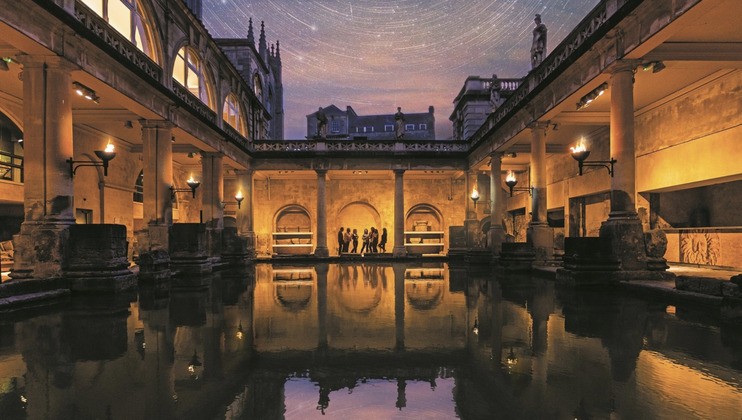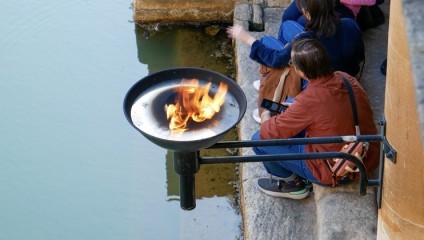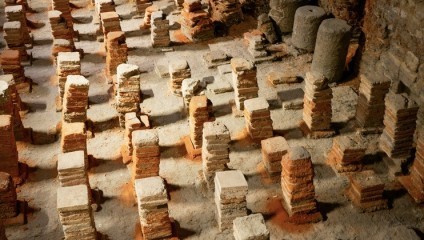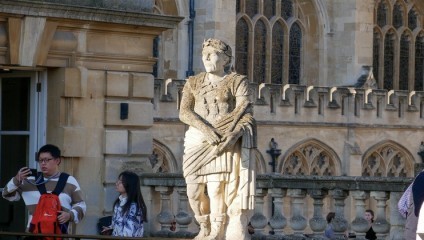Explore The Roman Baths
Have you ever wondered what it was like to unwind like a Roman? Whether you're a history lover, a spa aficionado, or just someone with a taste for the extraordinary, the Roman Baths are about to take you on a journey you won't soon forget. So, grab your sandals (real or imaginary), and let's get ready to explore the intriguing world of ancient relaxation!

Discover one of the finest spas of the ancient world at The Roman Baths and Museum in the heart of Bath.
Walk on Roman pavements, explore the historic bath houses, get up close to the golden goddess Minerva, and discover how the people of Britain lived, worshipped, and relaxed in Aquae Sulis, as Bath was once known as.
Our visit to The Roman Baths experience starts in the glorious domed entrance, which then takes you through to the terrace which is where you will get your first glimpse of the Great Bath below you. Whilst you get up to speed with the audio guides, spend some time hanging out with the likes of Caesar (and other important icons/ deities of Roman Life depicted in sculptures) with epic views of Bath Abbey. Look down below and see the Great Bath, a massive, well-preserved pool that was the heart of the Roman bathing ritual. The greenish-blue water is naturally heated by hot springs, creating a mesmerizing sight rooted in 2,000 years of history...

Once you've taken in the atmosphere and architecture of the Great Bath, you'll be guided through to see the museum's many exhibits. The museum rooms include a diverse collection of artefacts discovered at the site, including ancient coins, sculptures, and everyday objects used by the Romans. Scaled-down models of the various connected buildings give us a sense of the many roles this site filled. Make sure to spend some time gazing at the fascinating temple pediment and Gorgon's head.
So where did all of this hot water needed for the facilities come from? Well, the natural mineral-rich hot springs that feed the Roman Baths are still active today - you'll feel the warmth when you get close to them. While visitors are not allowed to bathe in the historic baths, you can experience the hot spring water at the contemporary Thermae Bath Spa nearby, which offers a modern spa experience.
Marvel at the striking gilt-bronze head of the goddess Sulis Minerva – one of the most iconic and rare treasures of Roman Britain. Spot the famous Gorgon’s head that dominates the Temple pediment, and learn about the curse tablets, which were thrown into the Sacred Spring to seek divine retribution on those who had committed wrongdoings.

Another highlight is seeing the heated rooms (known by the Romans as a caldarium) which had sophisticated heating systems (known as a hypocaust) which involved pumping hot air under pillar-raised floors (see photo) which would then heat the room from below. It's a fascinating system that gives you a sense of the technical proficiency used by the engineers and builders of the time!
From 29 March 2024 to 1 April 2024, the site is hosting Easter Lates which is a rare chance to see the Great Bath illuminated by torchlight, explore the museum and collection at a relaxed pace, and enjoy a drink under the evening sky at our pop-up prosecco bar.
Plan your trip to The Roman Baths today.
Come face to face with history when you meet our real-life Romans: people who lived and worked in Aquae Sulis 2,000 years ago.

With our family-friendly trails, interactive exhibitsand captivating CGI projections and complimentary audio guides (8including a children’s version) the ancient world of Roman Britain will come to life as you travel through the museum.
Follow us on social media and see our website for up-to-date details on our events throughout the year, from family activities during school holidays to late night openings at Easter and through the summer.